Millet is a general term for classifying small-seeded grasses, often called food grains or dryland cereals, and includes Sorghum, Pearl Millet, Ragi, Chickpea Millet, Foxtail Millet, Proso Millet, Barnard Millet, Kodo Millet, and other Millets are included. Millet is a hardy crop with small seeds that can thrive in arid or rainfed areas under modest soil fertility and moisture conditions. Let’s check out the top 12 steps to boost Millet yield.
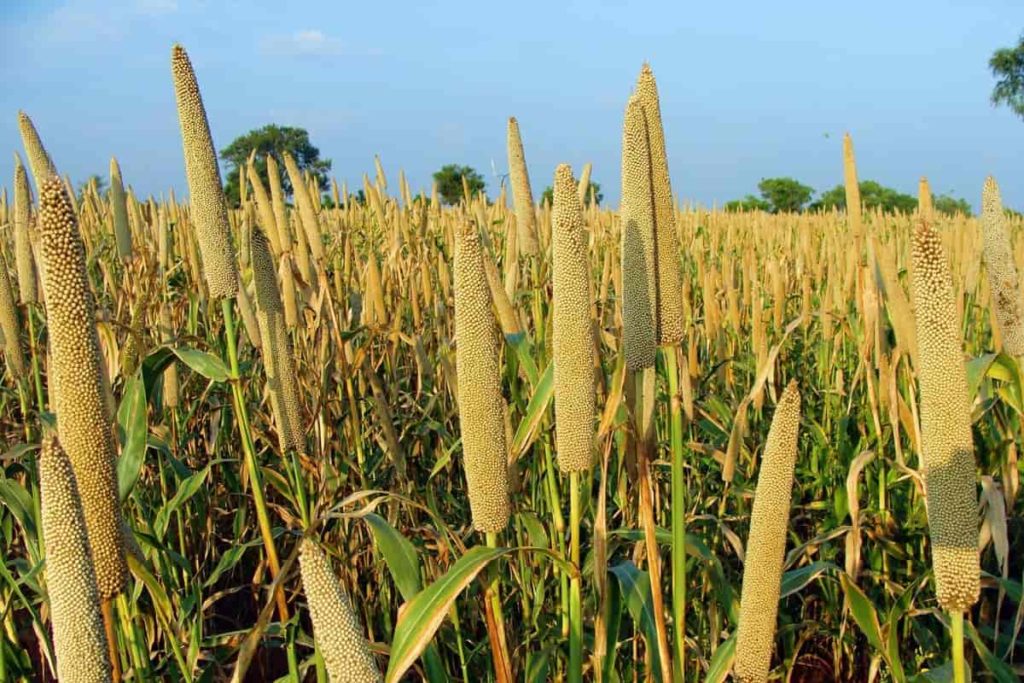
Millet is called ‘miracle grain’ or ‘crop of the future because it can grow in harsh conditions and is also a drought-tolerant crop that requires fewer external inputs. Minor Millets such as Kodo, Kutki, and Sama rice were grown by many farmers in the plains of Central India. Recently, due to an entire market focused on wheat and rice, some efforts have been made to promote Millet.
As a result, an increase in Millet cultivation will encourage the average farmer while achieving the goals of increasing income and crop diversification. Follow these below simple steps to get more yield in Millet cultivation.
Top 12 steps to boost Millet yield
Step 1: Climate conditions for maximum growth
Different types of Millet require different climatic conditions; however, the pattern of climatic conditions remains the same for almost all:
- Millet works best in well-draining hot sandy or clayey soils. Is. It prefers a neutral pH range for maximum growth.
- A warm, temperate climate is essential for the germination and germination of Millet seeds to maintain a comfortable soil temperature as they are susceptible to damage from cold weather and frost.
- The average temperature range of 26-29°C during growth is ideal for proper growth and good crop yield.
- Most Millets can do this with a little moisture because they have efficient water use capabilities. In India, about eight varieties of Millet are grown in rainfed conditions, which require little or no irrigation as they do not require much moisture. For example, Millet is a rain-fed crop (30-100 cm yearly) grown in areas that barely need irrigation. Generally, the average Millet requires less than 35 cm of rain, while some large Millets require at least 40 cm of rain for a good crop.
- Most Millets like Jowar, Ragi, Bajra, Sorghum, etc., are grown as Kharif crops, i.e., monsoon or autumn crops grown between June and November, requiring moisture rainfall. In addition, coarse grains are more adaptable and tolerant to climate shocks than other crops.
In case you missed it: Best Fertilizer for Finger Millet (Ragi): Organic, Bio-fertilizers, NPK, How and When to Apply
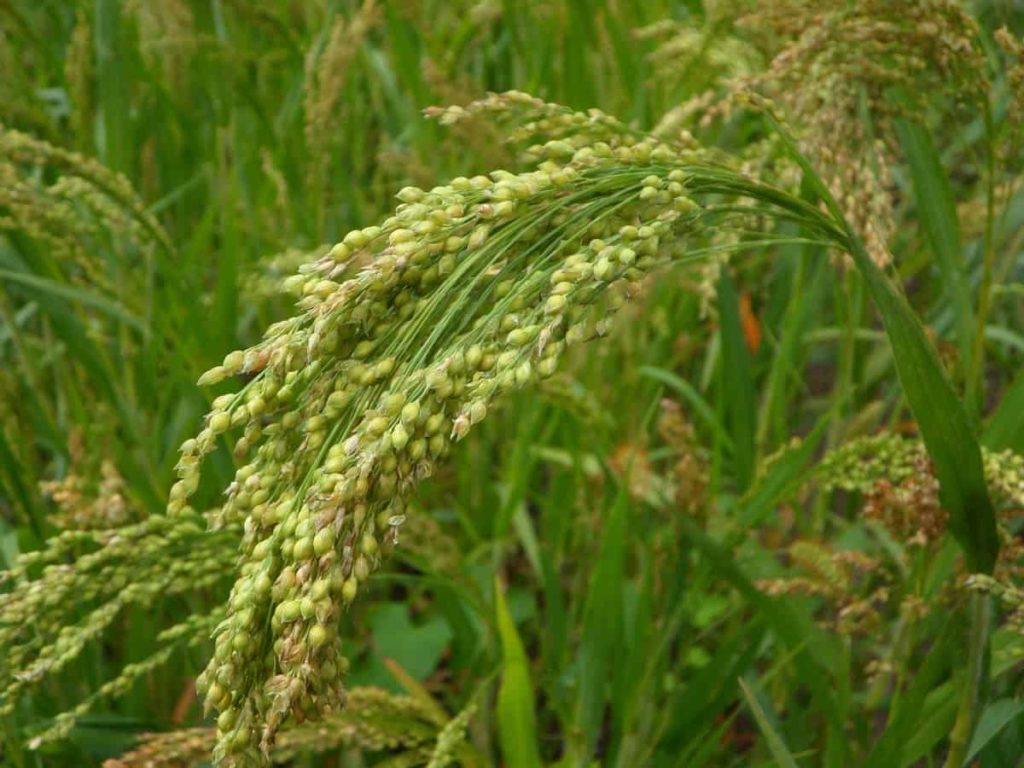
Step 2: Tips to increase Millet’s production
Millet is cultivated in less fertile lands, tribal and rainfed areas, and mountainous areas. Millets can grow not only in bad climates or soil conditions and provide nutritious grains and fodder but also because of their small growing season under irrigation and dryland cultivation. Millet is a dual-purpose crop. It is cultivated as both food and fodder, thus providing food security to millions of households and then contributing to the economic efficiency of farming.
Millet is considered a smart climate crop adapted by Indian farmers. Its yield success rate is much higher than other crops as it is a very low maintenance crop. It requires very little irrigation, and the fertilizer is not disease-resistant and in good demand in the market. Millet cultivation deserves encouragement, especially in its climatic flexibility, short crop duration, ability to grow with poor soils, mountainous areas, and low rainfall.
Because of their access to the poor, they can play an important role in providing nutrition to people of all income groups and adapting the climate to rain-fed farming systems. Millet is being promoted through the spread of technology, quality seeds through the Millet seed center, awareness-raising, and minimum support price. Promoting Millet can help governments save on health and nutrition costs.
Dedicated programs with appropriate training and capacity-building initiatives that encourage farmers to diversify their crops through Millet can be a timely way to pull farmers away from the region’s distress.
Step 3: Field preparation for proper growth and good crop yield
At the onset of the monsoon, the first plow should be plowed with a deep plow. Fine tillage is essential for proper germination and crop formation.
Step 4: Select different varieties of Millet
Barnyard Millet – It grows up to 2100 meters in height in subtropical and sub-tropical regions. 60-80 cm of rain is required annually. Temperature requirements are between 18-27°C. It grows well in sandy loam to clayey soils with high organic matter content and a pH between 5.5 and 7.5.
Finger Millet – It grows at high altitudes with extreme weather conditions. Grain ripening requires a dry spell and annual rainfall is about 70-120 cm. Temperature requirements are about 25-30°C. It grows well in red, black, sandy, loamy, and lateral soils with a pH of about 4.5-8.
Foxtail Millet – It grows in hot, barren, semi-arid, and tropical regions and can survive in poor water resources. Annual rainfall of 50-75 cm is required. Temperature requirements range from 15-30°C. Grows well in sandy loam with a pH of 5.5-7.
In case you missed it: Best Fertilizer for Bajra/Pearl Millet: Organic, NPK, Compost, When and How to Apply
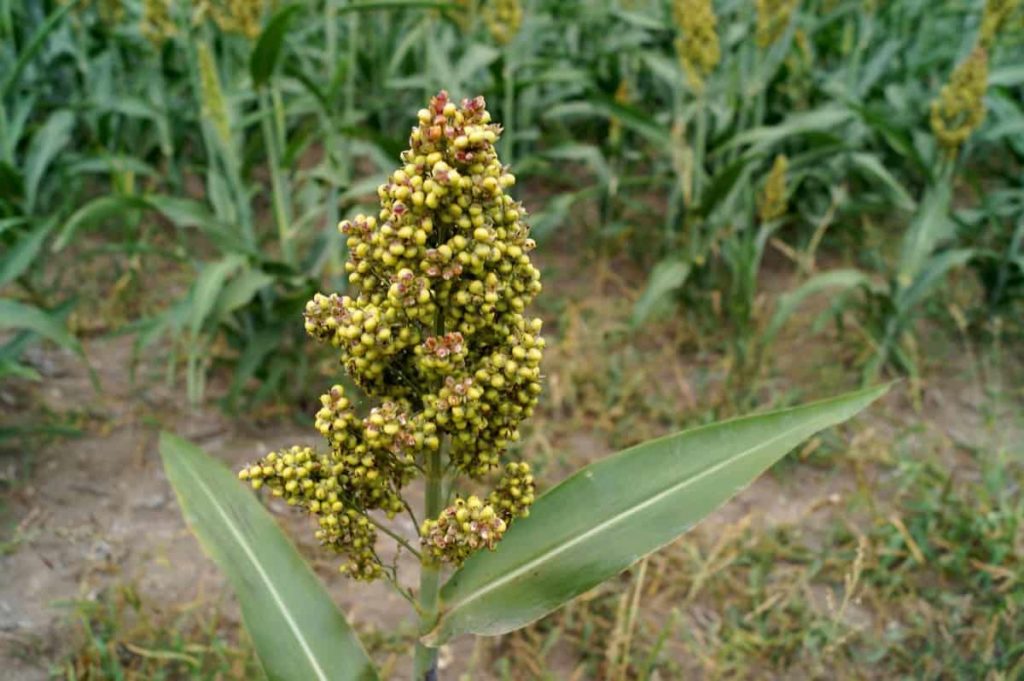
Proso Millet – Proso Millet is grown in India during Kharif and summer. It can also tolerate stagnant water to some extent. It is a hard crop that completes its life cycle in a short time. It can be grown in rich and poor soils, with variable textures, ranging from sandy loam to black cotton soils. Proso Millet can be sown in 3-4 cm deep skins by seed drill by broadcasting or line sowing.
Pearl Millet – It can be grown in different soils. Three sowing systems are practiced in pearl Millet: on a flat surface, using a ridge and furrow system, or a broad bed and furrow system. Seeds should be sown at 2.5 cm to 3 cm depth.
Improved breeds of Millet – Improved quantities of Millet can significantly increase Millet’s yield and field yield with disease resistance. For example, ‘Okashana 1’, a variety produced from the double production of naturally grown Millet in India. ‘Okashana 1’ has become the most popular variety and is an important food for consumers.
Step 5: Government measures to increase Millet production
Despite its many qualities, the use of Millet as food is limited to traditional consumers, the tribal population. Recently, Millet has gained attention, and efforts are on to get its easy and value-added processed products. Since many households in arid lands and mountainous areas rely on Millet to meet their food needs, it is time to enlarge the food basket and add Jowar, Bajra, Ragi, etc., to the public distribution system.
The government has recognized the role of Millet in the food chain. Under the NFSM, the share of Millet under the initial targets of an additional 25 million tonnes of food grain production under the National Food Security Mission is 2 million tonnes or 8% of improved food production. Indian policymakers turned their attention to the Millet farming system and formulated policies to create a conducive farming environment. Regarding Millet production, some of the existing schemes of the Government of India include;
- Integrated Cereals Development Program in Cropping System Areas based on Coarse Cereals under Macro Management of Agriculture.
- INSIMP-RKVY, part of the Rashtriya Krishi Vikas Yojana – the only comprehensive initiative to support Millet production – is an initiative for food security through the intensive promotion of Millet.
- Rainfed Area Development Program – RADP: A component of Rashtriya Krishi Vikas Yojana – RKVY.
- To develop and identify new areas receiving adequate rainfall for Millet cultivation as part of the Rashtriya Krishi Vikas Yojana (RKVY).
- Millet is being procured at subsidized rates and is included in the mid-day mail scheme and public distribution system to encourage its use. The government has also launched the ‘Integrated Cereals Development Program in Coarse Grains’ under the macro-management of agriculture.
- Millet is being promoted under the National Food Security Mission (NFSM) to provide good nutrition to those who cannot afford it.
In case you missed it: Types of Millets In India, Cultivation FAQs
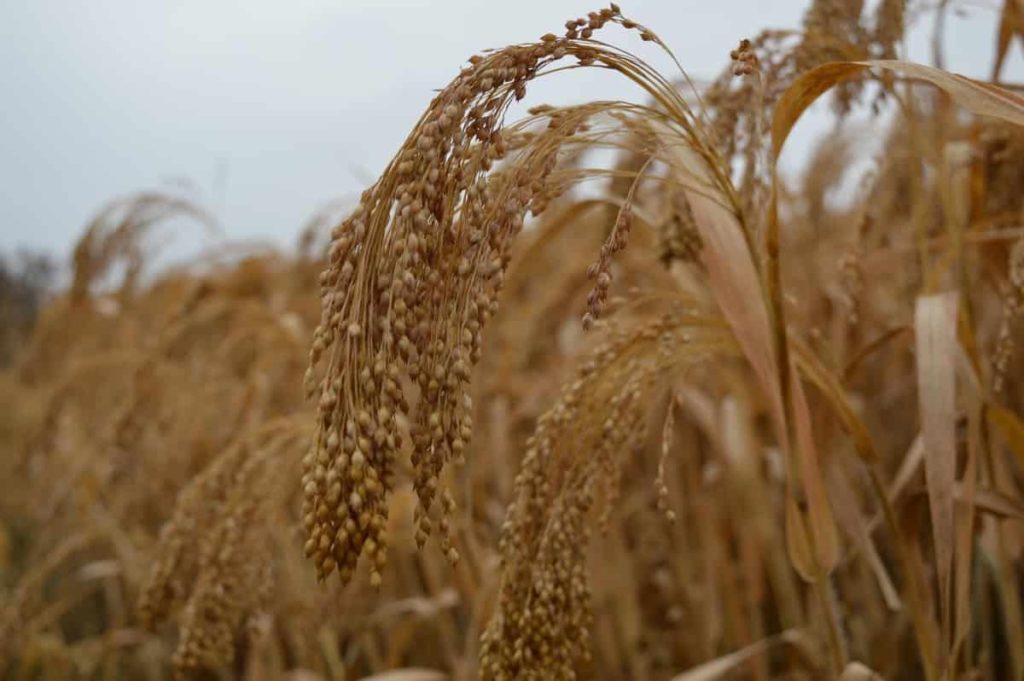
Step 6: Tips for successful Millet production
- Choose a plot for planting Millet that has a lot of sun exposure.
- Prepare the soil for planting by adding nitrogen-rich fertilizer to the soil. Plant individual seeds at least 2 inches (5 cm) apart. Cover the seeds with at least one inch (2.5 cm) of soil. Seed rows should be at least 12 inches (30.5 cm) apart.
- As the Millet grows, add extra or nitrogen-rich fertilizer to the soil. It is important because Millet releases a lot of nitrogen from the soil.
- Apply mulch around the Millet plants to help retain water. Do not water your Millet. Normal average rainfall should be sufficient for the growth of Millet, so no additional watering is required.
- Harvest your Millet when the grass and seed heads are golden brown.
Step 7: Fertility practices for more production
Millet is grown in less fertile soil, so fertilizing is optional. Focusing on high nitrogen products, such as feeder food, is your best option if you want to fertilize Millet. This plant can be susceptible to fertilizer burns, so do not apply it directly to the seed. Apply fertilizer at the planting time and again after four weeks. Millet is usually grown on less fertile lands.
Generally, 40-100 lb nitrogen and 30-60 lb phosphorus per acre are sufficient to produce grass or seeds, but for grazing, most fodder crops need more fertilizer to increase fodder production capacity and volume. The amount of fodder required and the number of livestock pastured will determine factors in planning nitrogen fertilization methods. Nitrogen requirements for heavy fodder production and heavy grazing may double those required for hay or seed crops.
Phosphorus requirements will also be higher than hay or seed crops. Soil tests are recommended to assess the need for nitrogen and phosphorus fertilizers and identify deficiencies in any other essential nutrients that may limit productivity. These nutrients mainly include magnesium, iron, copper, boron, manganese, zinc, potassium, sulfur, calcium, molybdenum, and chlorine.
Nitrogen is the most limiting nutrient in Millet farming. Nitrogen rates should be based on production targets and crop history. Excess nitrogen, whether applied or residual, can cause formation. Allow nitrogen to be used as fertilizer or other waste. Phosphorus and potassium should be applied as required based on soil recommendations. Fertilizer drill row application (except for direct phosphorus fertilizers) can cause seed injury and is not recommended. Millet is recommended for pH 5.6 or higher.
In case you missed it: Barnyard Millet Farming – Production Practices
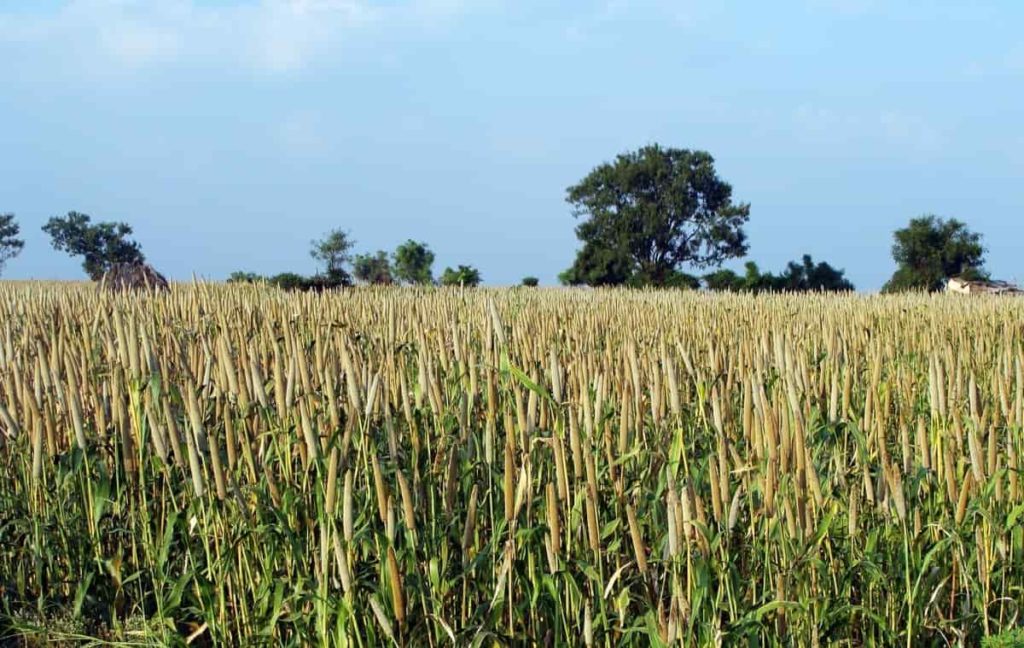
Step 8: Strategies for getting high yield
- Replace low yielding varieties with high yielding varieties/hybrids
- Creating awareness to farmers on the Millet importance in the nutritional requirement through training SHG/ farmers for production and value addition
- Conducting field demonstrations to showcase the productivity of high yielding varieties/hybrids with a package of nutrient management and production technologies
- Introduction of Millets in nontraditional districts where Millet is not grown.
- Increase in the area under small Millets in hilly areas
- Bringing in unutilized land into Millet cultivation under rainfed or drought situations
- Self-seed care
- Promotion of processing industries and value addition
- Commodity group for value addition high market value and fixing minimum support price for Millets
- Increase in MSP: The government has announced an increase in MSP (minimum support price) to encourage farmers to cultivate Millet.
- To increase the marketability of Millets, the government provided seeds and inputs to farmers through farmer’s producer organizations (FPO).
Step 9: Tips and tricks for growing Millet
Millet requires very little effort. There are only two things to cultivate: go to the field and broadcast the seeds, then come back three months later to harvest the grain. Millet is a low-maintenance crop that requires very little input. Farmers cultivate Millets mostly in the Kharif season. If there is good rain at regular intervals, farmers can expect a significant harvest. Average rainfall of 350-550 mm will suffice for Millet cultivation.
Millets are less susceptible to pests and diseases and can be used in intercrop or mixed crop cultivation without any pesticides. Millets are usually grown with legumes to obtain the desired results. Since standard Millet seeds are very small, care should be taken not to sow the seeds to a depth of more than 2 inches.
Sowing in a uniform line will be preferred over broadcasting so that the plant has access to all applicable inputs. Encouraging Millet cultivation is important because of its tolerance to climate, low crop length, and poor soils, its ability to thrive in mountainous areas, and with very little rainfall can play an important role in providing nutrition and helping to adapt the climate to rain-fed farming systems.
Step 10: Yield improvement tips
- Brasinosteriods 0.1ppm foliar spray at 30th and 50th DAS increased yields of pearl Millet grains
- Apply Cytokinin 10 ppm foliar spray at 40, and 50 DAS increased the Ragi grain yield
- Urea 2% foliar spray increased ragi grain production at 40 and 50 DAS
- KCl 1% + CaCl2 1% increase seed ragi grain production by seed hardening in rainy conditions
Step 11: Pests and diseases control for more production
Millets are highly resistant to insect attacks. It is a feature that mainly comes in handy when planning mixed crop farms using non-pesticide management methods. Separation of rows of more sensitive legumes is common on farms in different parts of the world.
In case you missed it: Proso Millet Farming, Cultivation Practices
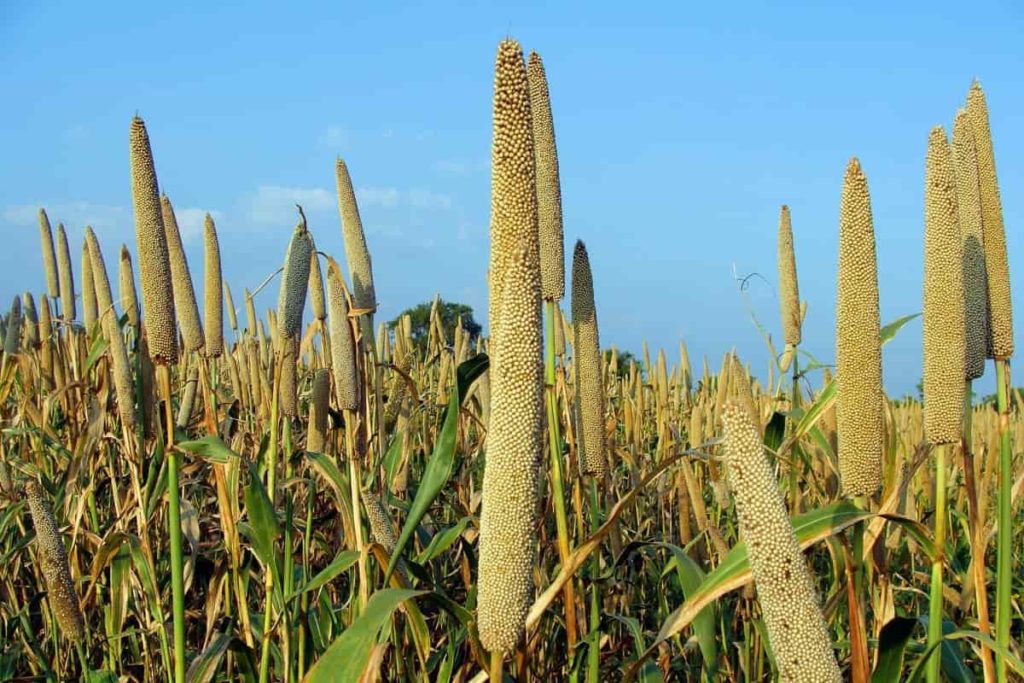
Diseases and their control
- Head Smut may be a problem in processed Millet, but it can be controlled with a seed treatment.
- Kernel Smut may be present in both Proso and Foxtail Millet. Effective control of this disease requires seed treatment and crop rotation, as the inoculum will remain in the soil for many years.
- Bacterial stripe disease has been found in Wisconsin and South Dakota. Affected plants have brown water-soaked lines on the leaves, blades, sheaths, and stems. Long narrow lesions show numerous thin, white scales of exudate. It is thought to be spread by seeds.
Insects and their control
Wheat Curl Mite — Foxtail Millet is known to harbor this insect that can transmit wheat streak mosaic to winter wheat. By early August, cutting the foxtail for hay and then pruning should kill the crop and prevent it from acting as a host.
Grasshoppers – These insects have been the most serious on the Millets. Insecticides used on Millet are used to control grasshoppers.
Armyworms – These worms may be common but can be controlled with pesticides. Also, some insects are minor bugs. When growing Millet, grasshoppers, army worms, chinch bugs, and false chinch bugs are all things to keep in mind. Spinosad and neem oil are very effective for fall armyworms. Armyworms can also be treated with BT spray, a liquid form of Bacillus thuringiensis. Chinch bugs can be treated with a spray of pyrethrin or Beauvaria bassiana, a natural fungus that cleans them.
Step 12: Harvesting tips for achieving maximum yield
When Millet is to be harvested depends on why it is being grown. To get the most nutritious grass, Millet should be harvested at the boot stage, meaning the head has grown and grown in size but is still closed in its sheath. At this point, they are prevented from achieving maximum yield and quality hay production. Plant growth slows down, and purple or brown seeds form heads.
In northern conditions, the crop is ready for harvest by October or about 70-90 days after sowing, when the upper half of the seed heads, or the panicles, turn brown. At this point, the lower seeds may still be in the soft flour stage but should no longer be green in color. Millet is sometimes threshed when the seed heads are about 2/3 brown and allowed to dry further in the field before combining.
This practice allows the straw to dry out and makes harvesting easier. It is also possible to cut the Millet crop on a combine with a common grain header. For grain, Proso Millet should yield about 50 bushels per acre or more, depending on the conditions. In the Northeast, the demand for Millet as a grain for bread and flour is increasing.
However, after harvesting and weeding the grain, it must be removed for human consumption. Millet seed hulls vary in color and can be stripped. Millet should be cleaned with weed seeds and broken kernels; it should not be stored at more than 13% moisture.
- Types of Pesticides Used in Agriculture: A Beginner’s Guide
- Economical Aquaculture: A Guide to Low-Budget Fish Farming
- 15 Common Planting Errors That Can Doom Your Fruit Trees
- How to Make Houseplants Bushy: Effective Tips and Ideas
- Innovative Strategies for Boosting Coconut Pollination and Yield
- Pollination Strategies for Maximum Pumpkin Yield
- The Complete Guide to Chicken Fattening: Strategies for Maximum Growth
- Natural Solutions for Tulip Problems: 100% Effective Remedies for Leaf and Bulb-Related Issues
- Revolutionizing Citrus Preservation: Towards a Healthier, Greener Future
- Natural Solutions for Peony Leaf and Flower Problems: 100% Effective Remedies
- Maximizing Profits with Avocado Contract Farming in India: A Comprehensive Guide
- Natural Solutions for Hydrangea Problems: 100% Effective Remedies for Leaf and Flowers
- The Ultimate Guide to Choosing the Perfect Foliage Friend: Bringing Life Indoors
- From Sunlight to Sustainability: 15 Ways to Use Solar Technology in Agriculture
- The Ultimate Guide to Dong Tao Chicken: Exploring from History to Raising
- The Eco-Friendly Makeover: How to Convert Your Unused Swimming Pool into a Fish Pond
- Mastering the Art of Delaware Chicken Farming: Essentials for Healthy Backyard Flocks
- 20 Best Homemade Fertilizers for Money Plant: DIY Recipes and Application Methods
- How to Craft a Comprehensive Free-Range Chicken Farming Business Plan
- Brighten Your Flock: Raising Easter Egger Chickens for Beauty and Bounty
- How to Optimize Your Poultry Egg Farm Business Plan with These Strategies
- Subsidy for Spirulina Cultivation: How Indian Government Schemes Encouraging Spirulina Farmers
- Ultimate Guide to Raising Dominique Chickens: Breeding, Feeding, Egg-Production, and Care
- Mastering the Art of Raising Jersey Giant Chickens: Care, Feeding, and More
- Ultimate Guide to Raising Legbar Chickens: Breeding, Farming Practices, Diet, Egg-Production
- How to Raise Welsummer Chickens: A Comprehensive Guide for Beginners
- How to Protect Indoor Plants in Winter: A Comprehensive Guide
- Ultimate Guide to Grow Bag Gardening: Tips, Tricks, and Planting Ideas for Urban Gardeners
- Guide to Lotus Cultivation: How to Propagate, Plant, Grow, Care, Cost, and Profit
- Agriculture Drone Subsidy Scheme: Government Kisan Subsidy, License, and How to Apply Online
- Ultimate Guide to Raising Araucana Chickens: Breed Profile, Farming Economics, Diet, and Care
- Bringing Hydroponics to Classroom: Importance, Benefits of Learning for School Students
- Ultimate Guide to Raising Polish Chickens: Breed Profile, Farming Economics, Diet, and Care
- Ultimate Guide to Raising Australorp Chickens: Profile, Farming Economics, Egg Production, Diet, and Care
- Silkie Chicken Farming: Raising Practices, Varieties, Egg Production, Diet, and Care
- Sussex Chicken Farming: Raising Practices, Varieties, Egg Production, Diet and Care
Very informative articles on various farming tips .keep up.